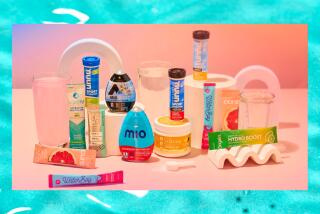Calcium--in Everything--Is Latest Food Fad
- Share via
A growing group of manufacturers is banking that calcium, the mineral believed to build strong bones in human bodies, also will build strong sales for their calcium-enriched food and beverage products.
Although the calcium product rush has been led by the pill and tablet market that exploded to $125 million in 1985 from a mere $18 million in 1980, growing concern about calcium deficiency has spilled over from drug store aisles and into grocery markets, prompting the introduction of a growing wave of calcium-enriched food and beverage products, and catapulting calcium deficiency into the nutrition issue of the decade.
The wave of calcium-enriched products includes a soft drink, flour, milk, breakfast cereal, chewable tablets and even a few products--diet drinks and antacids--simply reformulated to include more calcium.
Food and drink manufacturers have boosted the calcium content of their products to share in consumer reaction to a growing body of medical research that links calcium deficiency to osteoporosis. Moreover, newer research has suggested that the mineral deficiency might be related to colon cancer and hypertension.
The medical research enabled calcium pill and tablet manufacturers to record vastly improved sales during a time when overall vitamin and mineral sales had slowed.
During 1985, Os-Cal, a calcium supplement pill manufactured by Kansas City-based Marion Laboratories, was the nation’s third largest vitamin/mineral pill, topped only by a pair of multivitamin products.
The new food products are aimed at the millions of U.S. women who run the risk of developing osteoporosis later in life. The condition causes an estimated 1.3 million bone fractures annually, mainly among elderly women, according to the Food and Drug Administration.
Although the breaks occur in the hips, wrists and other calcium-deficient bones of older women, the most heart-wrenching condition has been “Dowager’s hump,” which reduces an elderly woman’s height as her spinal bones weaken and collapse.
“Calcium is exciting because it might provide a cure for a condition that, for so long, has been seen as an accepted part of growing old,” suggested Martha Homma, manager of public relations for Lederle Laboratories. The company, a division of American Cyanamid Corp., introduced Caltrate 600, a calcium supplement tablet, in 1984.
“It’s important for the public to know that despite some claims, this is not a manufacturer- or media-created event,” said Charles Rouse, manager of public affairs for Marion Laboratories. The company has captured 30% of the calcium pill supplement market with its Os-Cal calcium pill line.
Calcium’s growing popularity was generated largely by a 1984 National Institutes of Health conference which recommended that women who have entered menopause should be absorbing 1,500 milligrams daily. Most women actually absorb less than 550 milligrams of calcium, according to the FDA.
Calcium has not been identified as a sure-fire cure, however. Because of genetic and hereditary traits--women of North European extraction are most likely to suffer from osteoporosis--medical researchers have stopped short of branding calcium as a cure. And, for some women, increased calcium will create kidney stones.
Despite the plethora of products and the lack of a definite link between calcium deficiency and osteoporosis, growing numbers of women have determined that “the important thing is to find a (calcium) source and get on it,” said Neill Walsdorf, president of Mission Pharmacal, a San Antonio-based vitamin and mineral firm that introduced its first calcium supplement pill in 1949.
“The secret is trying . . . to densify your bones so when you inevitably lose calcium, you’re able to withstand (the disease) until the time you’re 85 or 90.”
Market Challenge
The marketing challenge for this new wave of calcium-enriched products has been to push them onto already crowded grocery and drug store shelves.
George Clark, who last year founded Carlsbad-based International Nutrition Technologies, is betting that he will grab part of the soft drink market with Calytes, a drink that contains an easily absorbed form of calcium. The drink, which is being bottled in City of Industry by Hansen’s Bottling, was introduced in San Diego last month on a test market basis.
If Calytes succeeds, the struggle will extend to grabbing space in vending machines and refreshment stands, according to a spokesman for Dimensional Marketing, a Chicago-based health-care advertising agency which is doing market research for International Nutrition Technologies, which is developing and marketing Calytes as well as a group of other health-related products.
Clark has positioned Calytes to grab part of the burgeoning “healthy” soft drink category which could grow to $5 billion--or 20%--of what is now a $25-billion soft drink market, according to Dimensional Marketing.
That kind of potential has attracted some major marketers.
Pet Inc., a St. Louis-based subsidiary of IC Industries, has already counted on Dairy Crisp, a calcium-enriched cereal introduced regionally in June, tapping into what a company spokesman identified as the “health-related adult cereal market,” valued at $500 million.
Pet, which spent $8 million during 1985 to advertise Dairy Crisp, turned to photographer Richard Avedon to provide the pictures that adorn the front of Dairy Crisp boxes. The photos feature “a woman over 30 whose hair is tinted with gray, a radical departure from most cereal ‘look-alike’ packaging,” according to Ad Week magazine.
Pet has also developed a calcium-enriched version of its existing Sego diet drink and is “exploring what other niches are appropriate for us to get into . . . (because) calcium is the health concern of the 1980s,” the spokesman said.
Last month, General Mills reformulated its popular Gold Medal Flour to include 20% of the U.S. recommended daily allowance of calcium. “If you were to eat two slices of bread (baked with Gold Seal’s general purpose flour) you’d now get 96 milligrams of calcium, compared to the previous 14.5 milligrams,” according to a company spokeswoman.
New Product
CalciMilk, a low-fat, lactose-reduced milk product with 500 milligrams of calcium per cup, recently was introduced in Philadelphia and New York by Lactaid Inc., a Pleasantville, N.J.-based company which plans to introduce a similar product in California later this year.
“Two cups a day gives you the U.S. RDA,” said spokeswoman Martha Turkington. “We’re offering the most absorbable form of calcium that there is and we’re putting it in milk, the best milieu for absorption.”
Warner-Lambert recently introduced Theracal and Suplical, a pair of chewable calcium tablet supplements that grew out of a “blending” of the Morris Plains, N.J.-based company’s confectionary product line (including Dentyne and Trident gums) and its medical line (including Listerine and Halls cough drops), according to a company spokesman. Warner-Lambert has also repositioned its sodium-free Rolaids product--which boasts a hefty slug of calcium--to share in the calcium surge.
Earlier this month, Marion Laboratories, which produces the most popular calcium pill, introduced a chewable tablet which will be sold in drug, grocery and mass merchandising stores. “It has the taste of Bavarian Cream or coconut, “ Rouse said.
Although nature offers several calcium-rich foods--including milk products, broccoli and salmon cakes--these new products have received a boost from human nature, particularly the female population’s general tendency to turn up its nose at calcium sources that are also heavy with calories, Clark said.
Clark and Walsdorf are betting that future research into how the body absorbs calcium will push consumers away from older products and pills and toward a new generations of calcium supplements.
“Fifty percent of all prescriptions that get written aren’t taken,” said Clark, who suggested that patients who balk at swallowing prescription pills and vitamin tablets would be more comfortable consuming “therapeutic foods and drinks.”
Clark and Walsdorf are also counting on increased consumer awareness to steer women toward their products.
For example, Walsdorf suggested that some calcium supplements--including the calcium carbonate-based antacids--are not always easily absorbed. Walsdorf claimed that its recent calcium citrate-based product, which was developed by the University of Texas Health Science Center, has achieved between 20% and 60% greater absorption than products featuring the more commonly used calcium carbonate.
Interestingly, if actuarial tables for men continue to show rises in life expectancies, men, too, might find themselves turning to calcium supplements.
“Although men start with a higher bone mass than women do and don’t lose (calcium) at a specific time like women do during menopause, if they live into their 80s, osteoporosis can be a significant problem,” according to Lederle’s Homma.
“We (men) usually don’t live long enough to get osteoporosis, but if (doctors) knock out cardiovascular and stroke (deaths), we’ll be candidates, too,” Walsdorf said.
More to Read
Eat your way across L.A.
Get our weekly Tasting Notes newsletter for reviews, news and more.
You may occasionally receive promotional content from the Los Angeles Times.










